Chai tea, with its comforting blend of spices and bold flavors, has become much more than just a beverage. It is a cultural icon that represents the rich traditions and flavors of India. Made with a combination of tea, milk, spices, and sweetener, chai tea has a unique taste that is both soothing and invigorating.
In India, chai is not just a drink, but a way of life. The tradition of chai culture developed out of British colonization, where the British introduced tea to India and the locals added their own array of spices to create a unique blend. Today, chai tea is enjoyed around the world for its distinctive flavor and numerous benefits.
Key Takeaways
- Chai tea is a cultural icon of India and is made with a combination of tea, milk, spices, and sweetener.
- The spices commonly found in chai include cardamom, cinnamon, ginger, star anise, and cloves.
- Chai is often served with various snacks such as cookies, sandwiches, samosas, pakoras, and murukku.
- Chai tea has a rich history that dates back thousands of years and is rooted in Ayurveda, a traditional medicinal practice.
- The taste of chai can vary depending on the spices used, offering a range of flavors from sweet and spicy to earthy and savory.
The History and Origins of Chai
Chai, a beloved and iconic beverage, has a history that spans over 5,000 years. The word “chai” itself is derived from the Hindi word for “tea” and is believed to have originated from the Chinese word “cha”. According to legend, chai was initially created as a healing spiced beverage in Ayurveda, an ancient Indian system of medicine that emphasizes the use of herbs and spices for health benefits.
The earliest versions of chai, known as “masala chai”, did not actually contain any tea leaves. Instead, they were made by combining a blend of aromatic spices such as ginger, black pepper, cloves, cardamom, cinnamon, and star anise. Over time, the addition of black tea leaves, milk, and sugar became popular, giving birth to the modern chai that we know today.
The introduction of black tea to chai can be attributed to British colonization in India during the 19th century. The British brought with them the tea plant from China and began cultivating it in India’s fertile lands, particularly in regions like Assam. Assam tea, known for its robust flavor, became a popular choice as the base for chai.
Chai quickly became ingrained in Indian culture, with its popularity spreading across the country and becoming a staple in households and tea stalls alike. It became a symbol of hospitality and a way to bring people together. Today, chai is enjoyed not only in India but also worldwide, cherished for its comforting flavors and aromatic spices.
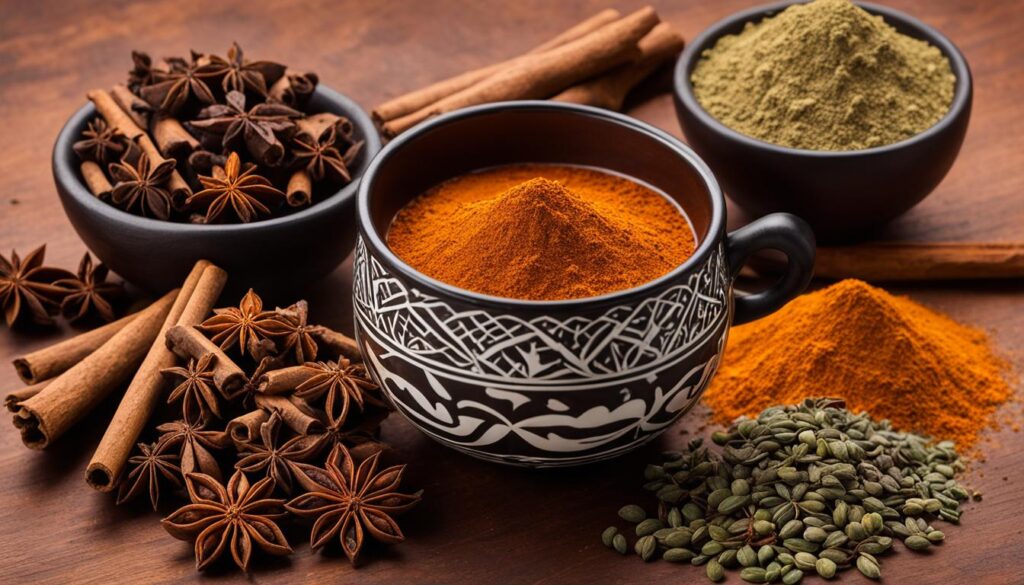
The Components of Chai
Chai, a beloved beverage with roots in Indian culture, is made up of various components that create its unique flavor and aroma. The key elements that make chai a delightful and comforting drink include tea, sweetener, milk, and spices.
Tea:
The type of tea used in chai can vary depending on personal preference and regional traditions. The most commonly used teas are Assam and Darjeeling black teas, which provide a robust and full-bodied base for the chai. However, green teas or herbal blends can also be used to create different flavor profiles.
Sweetener:
To balance the bold flavors of the tea and spices, chai is typically sweetened. The choice of sweetener can vary, with options such as white sugar, brown sugar, honey, or jaggery. Each sweetener lends its unique taste and sweetness to the final beverage.
Milk:
Milk is an essential component of chai, adding richness and creaminess to the drink. In India, buffalo milk is traditionally used in chai preparation, while in the Western world, cow’s milk or dairy alternatives are commonly used. The choice of milk can impact the overall flavor and texture of the chai.
Spices:
Spices are the heart and soul of chai, providing warmth, depth, and complexity to the beverage. The most commonly used spices in chai include cardamom, ginger, cloves, cinnamon, and black peppercorns. These spices are often ground or crushed before being added to the tea, allowing their flavors to infuse into the brew.
| Chai Components | Options |
|---|---|
| Tea | Assam tea, Darjeeling tea, green tea |
| Sweetener | Jaggery, white sugar, brown sugar, honey |
| Milk | Whole milk, buffalo milk, cow’s milk, dairy alternatives |
| Spices | Cardamom, ginger, cloves, cinnamon, black peppercorns |
Experiment with different combinations of these components to create your perfect cup of chai. Whether you prefer a classic blend with Assam tea and cardamom or a unique variation with green tea and ginger, chai is a customizable experience that can be tailored to suit your taste. Discover the harmony of flavors and indulge in the comforting embrace of chai.
The Tasting Experience of Chai
When it comes to tasting chai, the flavors can be quite diverse and intriguing. Depending on the spices used, each sip of chai can offer a unique and delightful experience. Whether you prefer a savory, sweet, or bitter profile, there is a chai flavor for everyone.
Fiery and Bold: Ginger and Black Peppercorns
If you’re looking for a chai with a fiery bite, opt for one that is heavy on ginger and black peppercorns. These spices add a robust and invigorating kick to your cup, leaving a satisfying warmth with every sip.
Sweet and Comforting: Vanilla, Cinnamon, and Nutmeg
If you have a sweet tooth, you’ll love chai flavors infused with vanilla, cinnamon, and nutmeg. These spices create a harmonious blend that offers a delightfully sweet and comforting note. It’s the perfect choice for those craving a cozy and indulgent beverage.
Earthy and Robust: Saffron and Fennel
Chai varieties with saffron or cacao offer a touch of earthy bitterness that adds depth and complexity to the drink. On the other hand, chai infused with fennel or cumin provides a more savory note, creating a robust and distinctive flavor profile.
The variations in chai flavors make it an enticing and dynamic beverage to explore. Whether you enjoy the fiery bite of ginger, the comforting sweetness of vanilla, or the robust earthiness of saffron, chai provides a diverse range of tastes to satisfy every palate.
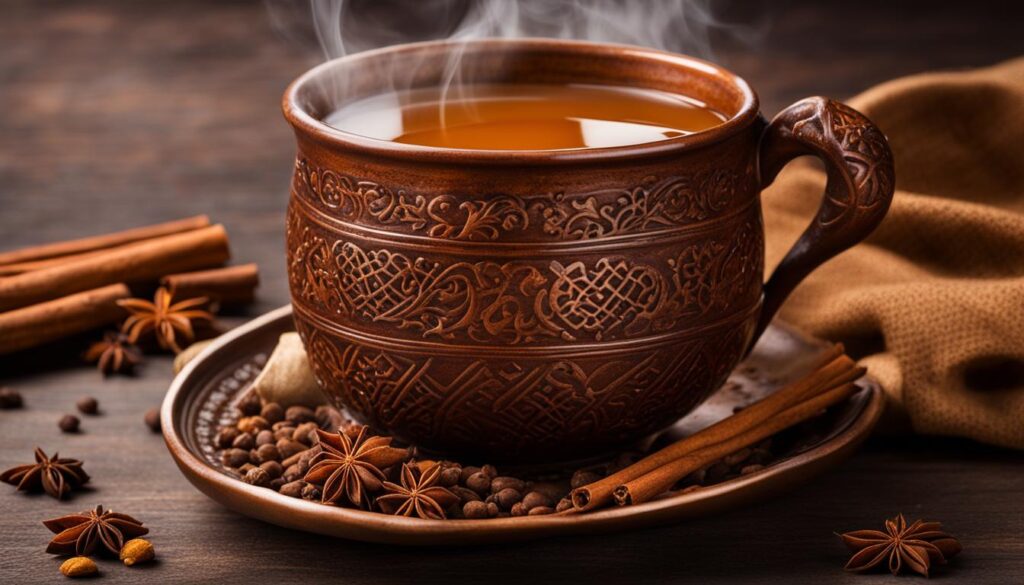
| Chai Flavors | Spices |
|---|---|
| Fiery and Bold | Ginger, Black Peppercorns |
| Sweet and Comforting | Vanilla, Cinnamon, Nutmeg |
| Earthy and Robust | Saffron, Fennel |
How to Prepare Chai
Preparing a perfect cup of chai is an art that varies depending on personal preferences and traditions. Whether you prefer to steep your chai in water alone, a mixture of water and milk, or in milk alone, the key is in finding your perfect balance of flavors. Here is a classic method for preparing a delicious cup of chai:
- Start by bringing water to a rolling boil in a saucepan or kettle.
- Add your desired chai blend or tea leaves to the boiling water.
- Let the tea steep in the boiling water for around 3-5 minutes, or according to the brewing instructions provided by the tea vendor.
- While the tea is steeping, you can heat milk in a separate saucepan until it begins to simmer.
- Once the tea has finished steeping, pour in the hot milk, adjusting the ratio of tea to milk based on your taste preferences.
- Add your desired sweetener, such as sugar, honey, or jaggery, and stir until dissolved.
- Allow the chai to simmer for an additional minute, infusing the flavors of the tea and spices.
- Finally, strain the chai into your cup or teapot, discarding any tea leaves or spices.
Now, sit back, relax, and savor the warm and comforting flavors of your freshly prepared chai. It’s a delightful beverage that can be enjoyed at any time of the day.
For those looking to experiment with their chai preparations, there are countless recipes available to suit different tastes and moods. From variations like masala chai with ginger, cardamom, and cloves, to unique twists like rose or chocolate chai, the possibilities are endless. Get creative and find your own signature chai blend that will leave you craving another cup.
“A perfect cup of chai is a harmony of flavors, a warming embrace that transports you to a place of comfort and indulgence.”
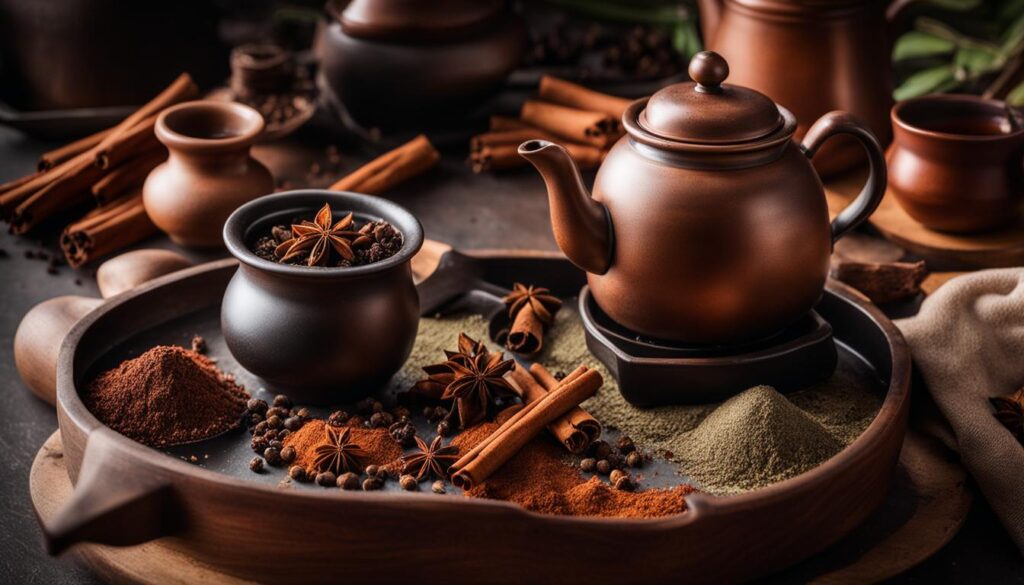
The Rise of Chai in the Western World
In the late ’90s, Starbucks introduced its own version of chai, which popularized the term “chai tea” in the Western world. Other coffee shops followed suit, and chai became a standard offering. Chai-flavored desserts and pre-made chai flavorings also started popping up in bakeries everywhere. The mainstreaming of chai was further highlighted by Oprah’s collaboration with Starbucks and Teavana to create different variations on chai, including ingredients like lemongrass, rooibos, and basil.
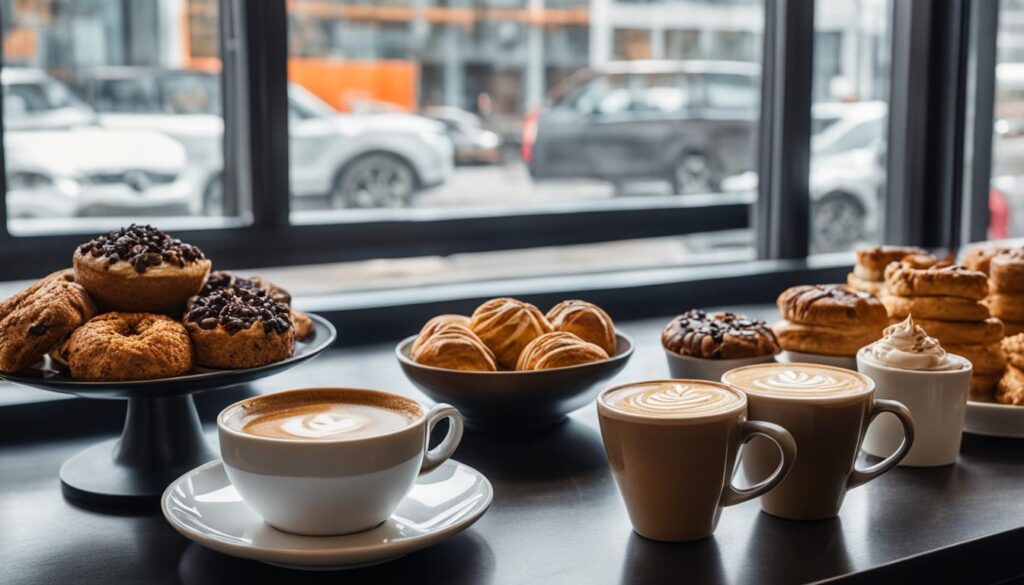
Chai’s journey from its humble origins in India to the Western world has been both exhilarating and transformative. The aromatic blend of spices, tea, milk, and sweetener has captured the hearts and taste buds of people across continents. Starbucks played a significant role in introducing chai to the Western audience, making it easily accessible and widely recognized. Today, chai tea can be found in almost every coffee shop, cafe, and tea house, catering to a diverse range of chai enthusiasts.
Chai at Starbucks: The Oprah Chai Tea
One of the notable milestones in the rise of chai in the Western world was the collaboration between Starbucks and Oprah Winfrey. In 2014, they introduced the Oprah Chai Tea, a unique blend inspired by Oprah’s love for the traditional Indian beverage. The Oprah Chai Tea featured a combination of black tea, cinnamon, ginger, cardamom, and cloves, creating a warm and comforting flavor profile. The partnership between Oprah and Starbucks not only brought chai to a wider audience but also raised awareness about the cultural significance and versatility of this beloved drink.
Chai Beyond the Cup: Chai-Flavored Desserts
The popularity of chai in the Western world extended beyond beverages. Chai’s distinctive flavor profile inspired the creation of chai-flavored desserts that captivate dessert lovers everywhere. Bakeries and patisseries started offering a variety of chai-infused treats, such as chai macarons, chai cupcakes, chai ice cream, and chai-spiced cookies. These delectable creations infused the aromatic spices of chai into classic desserts, adding a delightful twist to familiar flavors and enticing customers with their unique taste experiences.
Chai has truly made its mark in the Western world, expanding its presence from coffee shops to the realm of desserts. The versatility and depth of flavors in chai continue to inspire creative culinary innovations and provide a delightful indulgence for chai enthusiasts.
The Tea Culture in India
Tea holds a sacred place in the heart of Indian culture and is an integral part of daily life. From the bustling streets of major cities to the serene villages, the aroma of freshly brewed tea wafts through the air, inviting people to partake in this cherished beverage.
One can find chai-wallahs, or tea vendors, stationed on street corners, serving piping hot cups of tea to locals and visitors alike. These chai-wallahs are an iconic part of Indian culture and outnumber the chain cafés that have made their way into the country. They are purveyors of tradition, offering a taste of authenticity with every sip.
India is home to over 100,000 tea estates, sprawling across its picturesque landscapes. These tea gardens employ millions of tea workers, who diligently pluck the tea leaves by hand to ensure the highest quality. The labor and dedication put into the tea industry contribute to the rich flavor and aroma of every cup.
Tea consumption in India is unparalleled, with 70 percent of the tea produced in the country being consumed domestically. The love for tea transcends all boundaries of race, religion, and caste, bringing people together in their shared appreciation for this beloved beverage.
Regional Variations
Tea traditions and types vary across different regions of India, reflecting the diverse cultural tapestry of the nation. In the foothills of the Himalayas, the delicate and floral notes of Darjeeling tea reign supreme, earning it the title of the “Champagne of teas.” In contrast, the mighty flavor of Assam tea, grown in the lush plains alongside the Brahmaputra River, captivates tea enthusiasts with its boldness.
While masala chai, a spiced milk tea, is a staple throughout the country, the choice of spices and preparation methods differ based on regional preferences. The South Indian states of Tamil Nadu and Kerala indulge in the fragrant and creamy flavors of cardamom-infused tea, while in Rajasthan, a dash of saffron adds a touch of luxury to the beverage.
In each region, tea takes on a unique personality, reflecting the local culture and customs. Whether it’s the bustling streets of Mumbai or the serene tea gardens of Darjeeling, tea is a unifying thread that connects people and traditions across India.
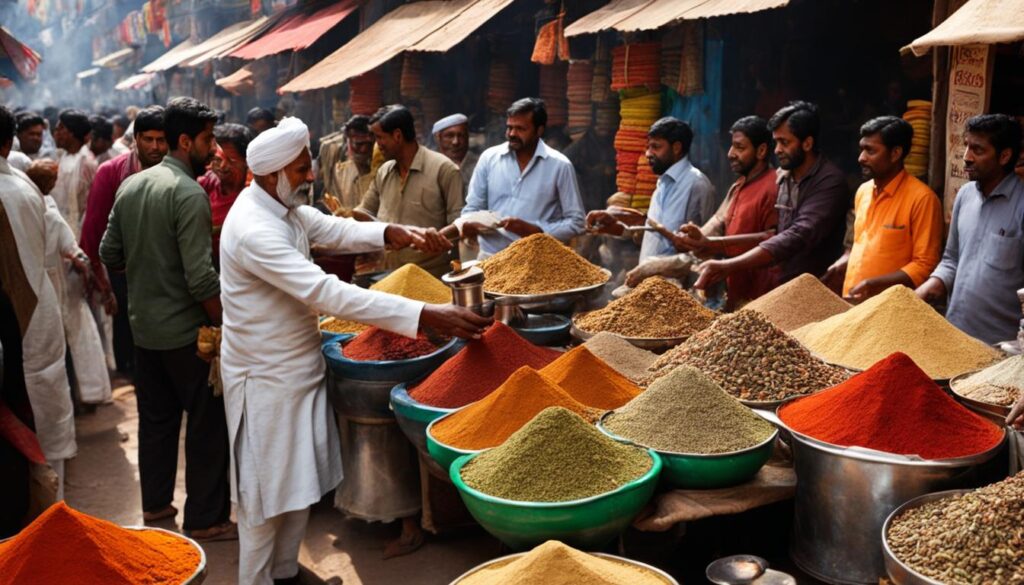
Tea culture in India is a celebration of flavors, traditions, and community. It is an experience that goes beyond the simple act of drinking tea, inviting individuals to immerse themselves in a culture that has thrived for centuries.
Assam Tea: The Mighty Flavor of India
Assam, located on both sides of the majestic Brahmaputra River, is renowned as one of the largest tea-growing regions in India. Here, amidst its fertile plains, thrives a tea industry that produces bold-flavored black tea, known for its rich and robust taste.
The tea bushes in Assam are known for their thick and lush plants with large leaves, which contribute to the distinctive characteristics of Assam tea. The region’s unique climate and soil conditions further enhance the flavor profile of the tea, resulting in a bold and malty taste that captivates tea lovers around the world.
Assam tea holds a prominent place in Indian tea consumption, with its strong and full-bodied flavor often serving as the foundation for masala chai, the beloved spiced tea enjoyed across the country. Its popularity and consumption are supported by the Tea Board India, an organization dedicated to promoting the growth and development of the tea industry.
Experience the mighty flavor of Assam tea, with its deep amber hue and satisfyingly bold taste. Whether enjoyed on its own or as the base for a delightful cup of masala chai, Assam tea is a testament to the rich heritage and exceptional quality of Indian teas.
“Assam tea is the embodiment of India’s tea heritage, with its bold flavor and unparalleled character.”
Darjeeling Tea: The Fickle Elegance of the Himalayas
Darjeeling tea, often hailed as the “Champagne” of teas, is renowned for its exquisite flavor profiles and delicate nature. This black tea from the Himalayas is considered one of the finest teas in the world, appreciated batch-by-batch, much like the art of wine tasting.
With its fickle nature, Darjeeling tea reflects the unique terroir of the region and the skillful craftsmanship of its producers. The tea is meticulously cultivated in the foothills of the Himalayas, where the cool mountain air and rich soil lend their magic to the tea bushes.
Darjeeling tea is known for its distinct seasonal flushes, each with its own character and flavor. The highly anticipated first flush, also called the “Champagne of teas,” offers a light, floral cup with a sweet and delicate taste. The second flush, with its bold and muscatel flavors, provides a richer and more robust experience. And during the monsoon flush, the tea leaves absorb the moisture, imparting a unique character to the brew.
To fully savor the nuances of Darjeeling tea, it’s essential to follow the specific brewing instructions provided by the tea makers. The brewing time and water temperature can greatly affect the taste profile, allowing you to unlock the true essence of this exceptional tea. While some may use lesser-quality Darjeeling teas as a base for masala chai, purists appreciate its elegance and complexity when enjoyed on its own.
FAQ
What are the ingredients of chai tea?
The basic components of chai tea are black tea, milk, spices, and sweetener. The spices commonly found in chai include cardamom, cinnamon, ginger, star anise, and cloves. The sweetener used in chai is typically plain white sugar.
What is the history of chai?
Chai has a rich history that dates back more than 5,000 years. It originated in India and was initially used for healing purposes in Ayurveda. The addition of black tea leaves, milk, and sugar was popularized thousands of years later.
What are the components of chai?
The components of chai include tea, sweetener, milk, and spices. The tea used is typically Assam or Darjeeling black tea, but other types of tea can be used. The sweetener can be white sugar, brown sugar, honey, or jaggery. Milk is an essential component, and spices commonly found in chai include cardamom, ginger, cloves, cinnamon, and black peppercorns.
What does chai taste like?
The taste of chai can vary depending on the spices used. Chai with more ginger and black peppercorns can have a fiery bite, while those with more cinnamon or nutmeg may have a sweeter note. Chai with saffron or cacao may have some earthy bitterness, and chai with fennel or cumin may have a more savory note.
How do you prepare chai?
There are different methods for preparing chai, but a classic method involves steeping the chai blend in boiled water for a certain amount of time, then adding hot milk and desired sweetener before straining and enjoying. The specific brewing instructions may vary depending on the chai blend.
How did chai become popular in the Western world?
Chai was popularized in the Western world when Starbucks introduced its own version of chai in the late ’90s. Other coffee shops followed suit, and chai became a standard offering. Chai-flavored desserts and pre-made chai flavorings also became popular.
What is the tea culture like in India?
Tea is deeply ingrained in the culture of India. Chai-wallahs, or tea vendors, can be found on the streets of major cities and small villages, outnumbering chain café establishments. India has over 100,000 tea estates employing millions of tea workers, and tea is consumed throughout the day by people of all races, religions, and castes.
What is Assam tea?
Assam tea is a bold-flavored black tea that is one of the largest tea-growing regions in India. The region, located on both sides of the Brahmaputra River, benefits from its fertile plains. Assam tea is widely consumed in India and is often used as a base for masala chai.
What is Darjeeling tea?
Darjeeling tea is often referred to as the “Champagne” of teas due to its fickle nature and fine flavor profiles. It is considered one of the finest black teas in the world and is appreciated batch-by-batch. While some less nuanced Darjeeling teas may be used as a base for masala chai, it is generally enjoyed on its own.